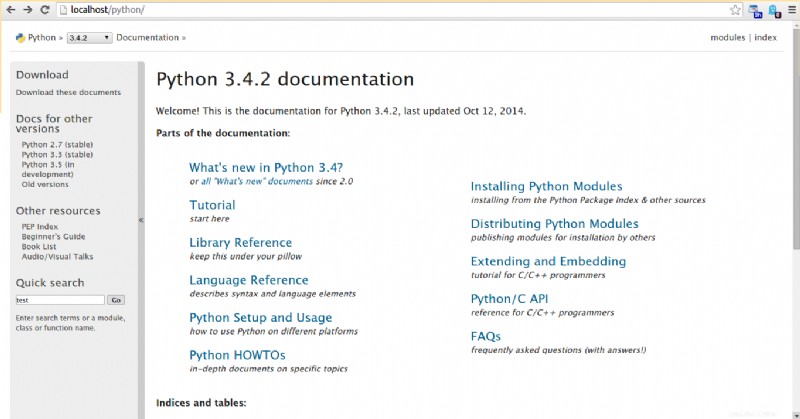http://www.google.cz/search?q=linux+chm+viewer
I documenti sono disponibili in vari formati:http://docs.python.org/download.html
Esiste un server di documentazione Python, che puoi eseguire localmente:http://docs.python.org/library/pydoc.html?highlight=pydoc#pydoc
Puoi anche installare Ipython per ispezionare i moduli/oggetti in modalità interattiva.
Ad esempio, puoi farlo in ipython:
import pygame
pygame.draw.line?
quindi ottieni il risultato doc:
pygame.draw.line(Surface, color, start_pos, end_pos, width=1):return Rect
disegna un segmento di linea retta
In ipython puoi usare la tab complition, è utile per ispezionare qualcosa.
Se usi la distribuzione Fedora, allora yum install python-docs . Altre distribuzioni possono fornire pacchetti simili.
Documentazione online
Il modo più semplice è utilizzare Google per accedere alla documentazione online. Non esiste un unico punto in cui trovi tutte le documentazioni di tutti i moduli. Tuttavia, alcuni comuni sono:
- Python 3
- NumPy e SciPy
- Teano
Se hai bisogno di documentazione offline ci sono alcune altre possibilità:
Scaricalo
Puoi scaricare la documentazione in formato HTML o PDF:https://docs.python.org/3/download.html
Quando hai un server web in esecuzione, puoi utilizzare la versione HTML e accedervi come sei abituato tramite un browser. Il sito HTML ha l'aspetto a cui sei abituato. Anche la ricerca funziona offline, perché è implementata con JavaScript.

PyDoc
Alcune distribuzioni come Debian offrono un python-doc pacchetto. Puoi accedervi tramite pydoc -p [some port number] o tramite pydoc -g . Questo creerà un server web locale. Quindi puoi aprire il tuo browser e dare un'occhiata:

Console:aiuto(...)
La console interattiva Python ha un help(...) integrato sistema. Puoi invocarlo senza argomento:
$ python
Python 2.7.5+ (default, Feb 27 2014, 19:37:08)
[GCC 4.8.1] on linux2
Type "help", "copyright", "credits" or "license" for more information.
>>> help()
Welcome to Python 2.7! This is the online help utility.
If this is your first time using Python, you should definitely check out
the tutorial on the Internet at http://docs.python.org/2.7/tutorial/.
Enter the name of any module, keyword, or topic to get help on writing
Python programs and using Python modules. To quit this help utility and
return to the interpreter, just type "quit".
To get a list of available modules, keywords, or topics, type "modules",
"keywords", or "topics". Each module also comes with a one-line summary
of what it does; to list the modules whose summaries contain a given word
such as "spam", type "modules spam".
help>
oppure puoi chiamarlo con un parametro di cui vuoi sapere qualcosa. Può essere qualsiasi cosa (un modulo, una classe, una funzione, un oggetto, ...). Assomiglia a questo:
>>> a = {'b':'c'}
>>> help(a)
Help on dict object:
class dict(object)
| dict() -> new empty dictionary
| dict(mapping) -> new dictionary initialized from a mapping object's
| (key, value) pairs
| dict(iterable) -> new dictionary initialized as if via:
| d = {}
| for k, v in iterable:
| d[k] = v
| dict(**kwargs) -> new dictionary initialized with the name=value pairs
| in the keyword argument list. For example: dict(one=1, two=2)
|
| Methods defined here:
|
| __cmp__(...)
| x.__cmp__(y) <==> cmp(x,y)
|
| __contains__(...)
| D.__contains__(k) -> True if D has a key k, else False
|
| __delitem__(...)
| x.__delitem__(y) <==> del x[y]
|
| __eq__(...)
| x.__eq__(y) <==> x==y
|
| __ge__(...)
| x.__ge__(y) <==> x>=y
|
| __getattribute__(...)
| x.__getattribute__('name') <==> x.name
|
| __getitem__(...)
| x.__getitem__(y) <==> x[y]
|
| __gt__(...)
: (scroll)